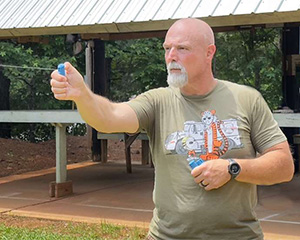I get a lot of questions about pepper spray, but the most frequently asked question is “Is pepper spray easy to carry and where do you put it?” Another one is “How much practice do I really need, and do words really matter?” These questions may be easy for me to answer, but it may be difficult for some people to get into the groove of carrying it every day.
In part one, I talked about “Making Pepper Spray Easy to Carry” and now let’s talk about how to integrate pepper spray with verbal commands.
My goal with part one was to encourage you to carry pepper spray (or have it at your fingertips) by simply reading how easy it is and where others chose to carry their non-lethal deterrent.
My goal with part two is to encourage you to practice with an inert practice unit. I would like for you to practice enough that you figure out which carry position works best for you, then find a simple command that resonates with your personality and then work that system.
I am a lucky person to have a diverse group of friends. I reached out to a handful of incredible pepper-spray trainers, mindset advocators, firearms instructors and alumni of our company, The Complete Combatant, with two questions:
- How much practice do I really need?
- Do words really matter? Is it best to give a command when I must use pepper spray or can I just “spray”?
“If I’m using pepper spray outside the police context, I want it to be a surprise. I’ll do the standard Managing Unknown Contacts (MUC) style verbal commands upon the suspect’s encroach, but I won’t say anything before I spray him. I don’t want him taking any countermeasures before he gets hit with the spice,” Greg Ellifritz, Active Response Training.
“My ‘go to words’ are ‘Get back!’ I am unsure if it will have an effect on the assailant. but l suspect it will on any witnesses in near proximity. This may support my claim that my use of force was defensive,” Steve Moses, Palisade Training Group.
“I say something like, ‘This stuff is about to melt your face off,’ out loud but if you’re referring to what I say in my head, it’s to give them the hot sauce blessing which means move the spray left to right above the eyebrows and forehead to chin,” Alex Bleam, Castle Keepers.
Forceful commands are easy to understand
“’Stop! Don’t come any closer! Alto! No me acerca mas!’ The object is to set a boundary so I establish a verbal boundary that can’t be misunderstood; no closer. Reiterate commands in Spanish because of demographics,” Claude Werner, The Tactical Professor.
“’Don’t move!’ – setting a distance boundary that would be my go signal to spray them if they continue their actions which also reminds me to get moving,” Brian Hill, The Complete Combatant
“‘Stop’ or ‘Get back.’ Loud, clear, short and likely understood should the person not speak English,” Angela Humphries, OnPoint Personal Defense.
“It’s going to be situationally dependent. I try to keep the spray hidden until it’s actually dispensed, and don’t want to warm someone verbally about OC spray. The words are typically something like ‘Get back, leave me alone, let me leave.’ I want the attacker and anyone else within earshot to know I am not the aggressor and I want to disengage,” Dave Reed, Everyday Defensive Solutions.
When I asked Vicki Farnam, she had this to say “You certainly could, all depends on circumstances. You could use words with spray concealed or visible in your hand but maybe you have already said those words to no avail. Only recourse left is to spray. As you are so adept at saying in your on-line class, paying attention to what is happening in real time and the proximity of the threat will determine if there is time for more words.” Vicki Farnam of FlexCCarry Solutions: A Positive Guide to Off-Body Carry

“I practice presenting pepper spray with verbal commands, but maybe not as much as I should. I practice 10 to 1 with 10 being dry practice with my firearm. And yes, as a Peace Officer, I believe that words do matter”. Chris Griese, The Practical Guardian.
“In my outside commanding voice, from my diaphragm, ‘Stop. Come no closer. Stop,’ as I’m backing up. I learned to use my commanding voice, not necessarily the words I choose,” Kathlynn Joel-Reich of Fundamental Enlightenment.
“I practice a pepper spray unit draw from pocket every time I place in my pocket in the morning to be sure it’s placed properly. Sometimes I say words in my head and sometimes out loud,” Shannon Pable, Shannon’s Garden and Gun Gallery.
“I don’t have a set verbal loop I use. Sometimes it’s unannounced and sometimes it’s the Make part of the Ask/Tell/Make verbal escalation tactic I prefer,” Mark Luell, Growing Up Guns.
Look at how different we are when it comes to practice and verbal commands. I think a good place to start would be to “know thyself.” What is your learning style? Do you need a ton of reps to cement techniques into your brain? Do you work better with a partner or alone? Are you a “wordy” person? Do you have a temper and you need to regulate your actions and mindset? Once you answer some of these questions about yourself, then you are probably ready to think about how much practice you need and what words, if any, you want to practice using in a “I must pepper spray the person” scenario.
Read the full article here








